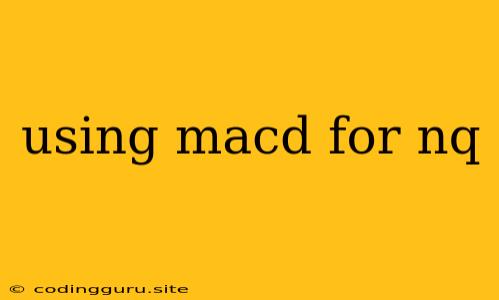Using MACD for NQ: A Comprehensive Guide
The NQ (Nasdaq 100 Futures) is a popular futures contract traded on the CME Group. Its high volatility and potential for significant gains make it a favored instrument for traders employing various strategies. Among them, the MACD (Moving Average Convergence Divergence) indicator stands out as a valuable tool for identifying trends and potential trading opportunities.
What is MACD?
MACD is a technical indicator that helps traders assess the momentum and direction of a financial instrument's price. It is calculated by subtracting a slower moving average (typically 26 periods) from a faster moving average (usually 12 periods). The difference between these two moving averages is then plotted as a line called the MACD line.
A second line, the signal line, is then added to the chart. This line is usually a 9-period moving average of the MACD line itself. MACD and signal lines are used to identify buy and sell signals when they cross each other.
Here are some key points to remember about MACD:
- Crossovers: When the MACD line crosses above the signal line, it signals a potential buy signal. Conversely, when the MACD line crosses below the signal line, it suggests a potential sell signal.
- Divergence: MACD can also be used to identify divergence, which occurs when the price of an asset moves in one direction, while the MACD indicator moves in the opposite direction. Divergence can be a signal that the current trend is weakening.
- Histogram: Some platforms include a histogram to visualize the difference between the MACD line and the signal line. This histogram can help identify the strength of a potential buy or sell signal.
How to use MACD for NQ Trading
MACD can be a versatile tool for trading the NQ, offering insights into both trend identification and potential buy/sell opportunities. Here's a step-by-step approach to effectively integrate MACD into your trading strategy:
- Choose your timeframe: MACD can be used on various timeframes, but it's crucial to find what works best for your trading style. For shorter-term traders, a 5-minute or 15-minute timeframe might be suitable. Longer-term traders might prefer a daily or weekly timeframe.
- Identify the trend: The first step is to determine the overall trend of the NQ. Is it trending upward, downward, or consolidating? This will help you identify potential support and resistance levels.
- Look for crossover signals: As mentioned earlier, MACD crossover signals can indicate potential buying or selling opportunities. A bullish crossover occurs when the MACD line crosses above the signal line. A bearish crossover occurs when the MACD line crosses below the signal line.
- Consider divergence: MACD divergence can also be a valuable indicator for identifying potential reversals in the market. When the price of the NQ is making higher highs, but the MACD indicator is making lower highs, it can suggest a potential sell signal.
- Use MACD in conjunction with other indicators: MACD can be combined with other technical indicators, such as moving averages, Bollinger Bands, and RSI, to provide a more comprehensive view of the market.
Tips for Using MACD for NQ
- Use multiple timeframes: Using MACD on multiple timeframes can help you confirm signals and identify potential trends.
- Look for strong signals: Not every MACD crossover is created equal. Look for strong signals that are confirmed by other indicators or price action.
- Use stop-loss orders: Stop-loss orders are essential for managing risk when trading NQ using MACD.
- Practice with a demo account: Before trading NQ with real money, it's highly recommended to practice using MACD on a demo account to familiarize yourself with the indicator and its signals.
Example of MACD in Action on NQ
Let's look at a hypothetical example to illustrate how MACD can be applied to NQ trading.
Imagine the NQ is trending upwards on a daily timeframe. The MACD line crosses above the signal line, indicating a potential buy signal. This crossover is further confirmed by the fact that the histogram is expanding, indicating a strong bullish signal.
You might consider entering a long position on the NQ at this point, with a stop-loss order placed below the recent support level. If the price continues to rise, you could hold onto your position until you see a bearish MACD signal, such as a crossover below the signal line or a significant divergence.
Conclusion
MACD is a powerful tool that can be used to identify trends and potential trading opportunities in the NQ market. By understanding its principles and implementing it effectively, traders can gain valuable insights into market sentiment and potentially improve their trading decisions. However, it's important to remember that MACD is just one tool in a trader's arsenal and should be used in conjunction with other forms of analysis to make informed trading decisions.
